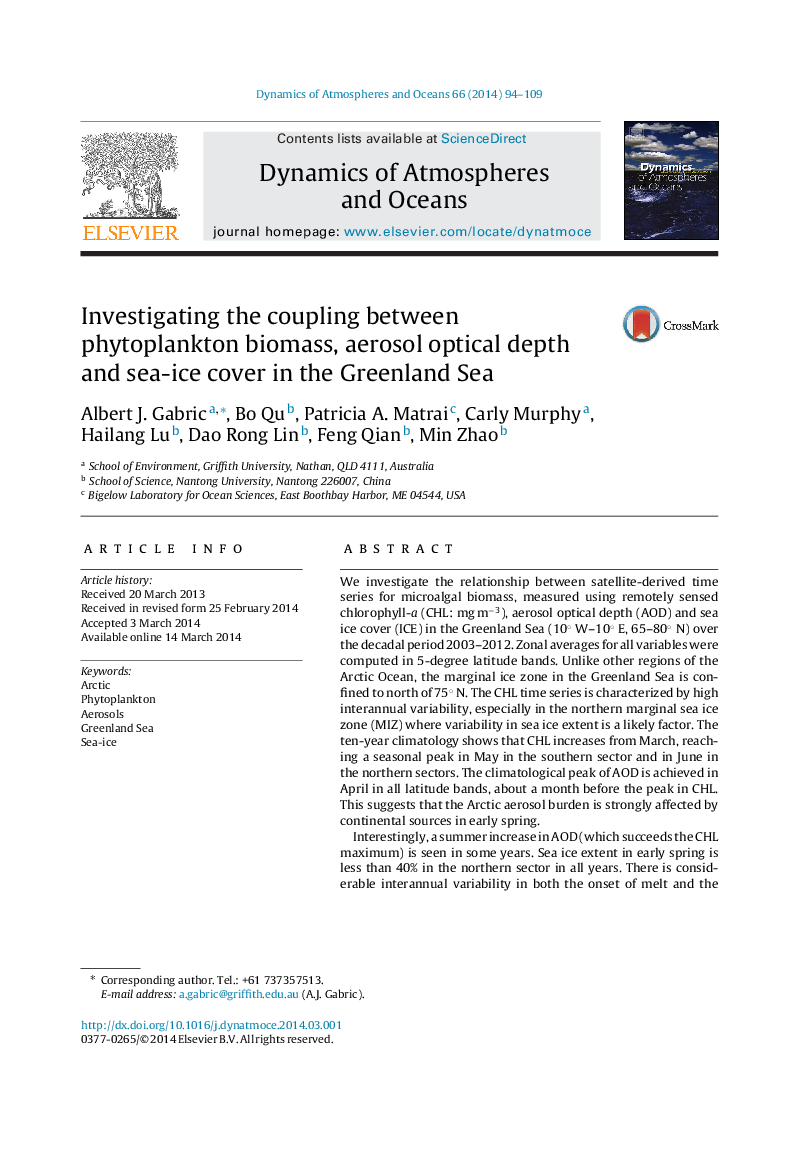| کد مقاله | کد نشریه | سال انتشار | مقاله انگلیسی | نسخه تمام متن |
|---|---|---|---|---|
| 4674031 | 1634224 | 2014 | 16 صفحه PDF | دانلود رایگان |
• We examine satellite-derived chlorophyll, aerosol and sea ice in the Greenland Sea.
• There is a moderate correlation between chlorophyll and aerosol in ice-free waters.
• We find no correlation between chlorophyll and sea ice.
• Peaks in aerosol during summer succeed the peak in chlorophyll.
• Marine biogenic aerosol emissions influence the aerosol burden during summer.
We investigate the relationship between satellite-derived time series for microalgal biomass, measured using remotely sensed chlorophyll-a (CHL: mg m−3), aerosol optical depth (AOD) and sea ice cover (ICE) in the Greenland Sea (10° W–10° E, 65–80° N) over the decadal period 2003–2012. Zonal averages for all variables were computed in 5-degree latitude bands. Unlike other regions of the Arctic Ocean, the marginal ice zone in the Greenland Sea is confined to north of 75° N. The CHL time series is characterized by high interannual variability, especially in the northern marginal sea ice zone (MIZ) where variability in sea ice extent is a likely factor. The ten-year climatology shows that CHL increases from March, reaching a seasonal peak in May in the southern sector and in June in the northern sectors. The climatological peak of AOD is achieved in April in all latitude bands, about a month before the peak in CHL. This suggests that the Arctic aerosol burden is strongly affected by continental sources in early spring.Interestingly, a summer increase in AOD (which succeeds the CHL maximum) is seen in some years. Sea ice extent in early spring is less than 40% in the northern sector in all years. There is considerable interannual variability in both the onset of melt and the extent of sea ice loss during summer, with the minimum summer sea ice extent decreasing to almost zero in five of the years. Cross-correlation analyses of the three times series identify a statistically significant relation between CHL and AOD in six of the years in the southern sector, but no correlation between CHL and ICE was found in the northern sector. There is, however, a significant correlation between AOD and ICE time series in the northern sector in four years. High AOD values registered in early spring are most likely of anthropogenic origin, however, peaks later in summer coincident with the phytoplankton bloom and high emissions of biogenic aerosol precursors such as dimethylsulfide and other primary aerosols of marine origin, suggest the summer atmospheric aerosol burden is likely influenced by biogenic emissions.
Journal: Dynamics of Atmospheres and Oceans - Volume 66, June 2014, Pages 94–109
